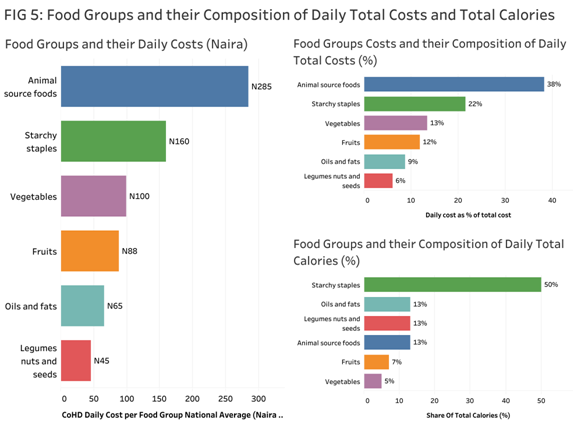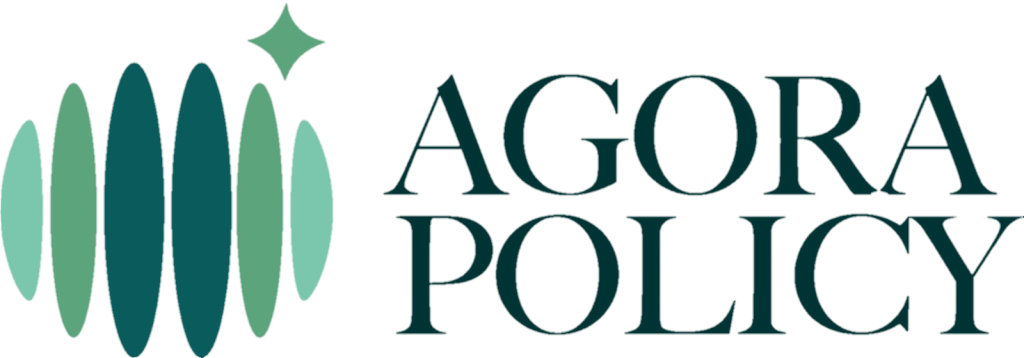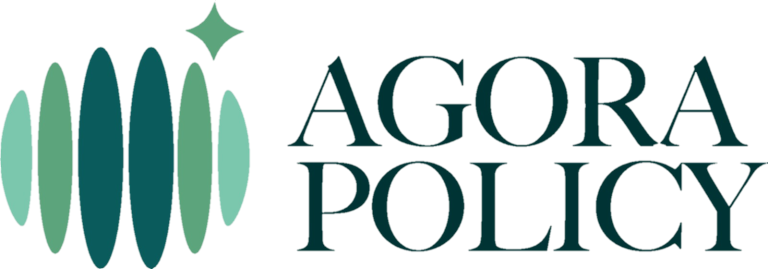
- Details
- By Agora Policy
- Blog
- Hits: 1062
By Samuel Ajayi | Artificial Intelligence (AI) has emerged as a pivotal force that is shaping and transforming lives, industries and economies around the world. AI has come a long way from the early days of the conceptual and visionary work of Alan Turing, who laid the groundwork for the field with his pioneering ideas.

- Details
- By Agora Policy
- Blog
- Hits: 1350
By Ayobami Ayorinde | On Monday, the National Bureau of Statistics (NBS) in collaboration with the Federal Ministry of Agriculture and Food Security (FMAS) and other key stakeholders released the National Agricultural Sample Census (NASC) for 2022. This is the first census report detailing the state of agriculture in the country since the last one released in 1993.

- Details
- By Agora Policy
- Blog
- Hits: 825
By Babajide Fowowe | Last week, the National Bureau of Statistics (NBS) released the first of a series of new reports, titled the Cost of a Healthy Diet (CoHD). The NBS defines the cost of a healthy diet as “the cost per day of the least expensive combination of foods that meets the daily requirements for a healthy diet for an adult”1. Thus, the CoHD represents the minimum daily requirements for an adult to obtain a healthy meal. The healthy diet basket consists of 11 food items: three items of vegetables, two items of starchy staples, two items of fruits, two items of animal source foods, one item of oils and fats, and one item of legumes, nuts and seeds2.
As would be expected in a diverse country such as ours, there are disparities in the cost of a healthy diet across rural and urban areas, states, geo-political zones, and over time. For example, in December 2023, the daily cost of a healthy diet was lowest in Katsina State with N594; while it was highest in Ekiti State with N1,052. This means that in order to maintain a healthy diet, the average adult in Ekiti State would have to spend almost double what the average adult in Katsina State would spend.
The availability of regular and consistent data on the cost of a healthy diet is very useful for a number of reasons. First, a healthy diet is critical for maintaining good health, which is a precursor to better standards of living. Second, knowledge about how costly a healthy diet is will be helpful in shaping policies around ensuring affordability of food. Third, the CoHD can help to track prices and highlight areas, states or zones where essential food prices are high, and inform efforts to tackle such high prices.
In what follows, we present six key insights from the CoHD reports recently released by NBS.
Insight 1: The National Average of the Cost of a Healthy Diet Increased by 68.3% between January 2023 and December 2023
The national average of the CoHD increased from N467 in January 2023 to N786 in December 20233 (Figure 1). This implies an increase of 68.3%. The average CoHD was below N500 from January till April, but increased to N503 in May. It increased to N515 in June and these increases continued until December. The steepest increase occurred between June and July when the COHD increased from N515 to N590 (14.6%), while the lowest increase occurred in March, with CoHD increasing from N478 to N480 (0.42%).
It is particularly insightful that the CoHD increased for each successive month throughout the year. One would have expected food prices to change with the seasons. In particular, it would have been expected that prices would be lower during the rainy season. However, costs increased by larger percentages during the rainy season. This suggests that some extraneous factors are affecting food prices. The second half of the year had the largest increases, perhaps reflecting the effects of the removal of petroleum subsidies and foreign exchange reforms.

Source: National Bureau of Statistics (NBS): The Cost of a Healthy Diet (CoHD)
Insight 2: The Cost of a Healthy Diet is Lower in Northern Nigeria than Southern Nigeria
Between October and December 2023, the average cost of a healthy diet was lowest in the North East at N633, followed by N644 in the North West, and N665 in the North Central Figure 2). For the same period, the average CoHD was highest in the South East at N919, followed by the South West at N872, and South South at N788. Thus, it costs more to buy a healthy food that constitutes a healthy diet in the southern part of the country than in the northern part.

Source: National Bureau of Statistics (NBS): The Cost of a Healthy Diet (CoHD)
Examination of the data for individual states reveals the same picture. All the northern states had CoHD below the national average, while Cross River was the only southern state with CoHD below the national average (Figure 3). Thus, interestingly, the national average seems to act like a dividing line between the northern and southern parts of the country. This is not particularly surprising, as the northern part of the country has historically produced more food than the south.

Source: National Bureau of Statistics (NBS): The Cost of a Healthy Diet (CoHD)
Insight 3: The Cost of a Healthy Diet is Lower in Rural Areas than Urban Areas
Between October and December 2023, the cost of a healthy diet was cheaper in rural areas than urban areas in 32 states (including the FCT), while CoHD was cheaper in the urban areas than rural areas in five states (Kebbi, Katsina, Kwara, Taraba, and Kaduna). There is wide disparity in the magnitude of these differences (Figure 4). The CoHD in the urban areas was higher than the rural areas by more than N100 in four states (Adamawa, Gombe, FCT, Bauchi). The difference was between N50 and N99 in six states (Nasarawa, Rivers, Imo, Niger, Anambra, Plateau). For the remaining states, the difference was lower than N50.

Source: National Bureau of Statistics (NBS): The Cost of a Healthy Diet (CoHD)
Insight 4: Animal Source Foods Account for the Largest Share (38%) of the Cost of a Healthy Diet while Legumes, Nuts and Seeds Account for the Lowest Share (6%)
Between October and December 2023, the average cost of animal source foods in the healthy diet was N285 (Figure 5). This represents 38% of the total average CoHD of N744 for these months (Figure 5). Starchy staples had the second highest daily cost of N160 (22%), followed by vegetables with a daily cost of N100 (13%). Fruits had a daily average cost of N88 (12), oils and fats cost N65 (9%), and legumes, nuts and seeds on average cost N45 (6%).
For the share of total calories, starchy staples accounted for the highest share (50%) (Figure 5). This is followed by oils and fats (13%), animal source foods (13%), and legumes nuts and seeds (13%), fruits (7%) and vegetables (5%). It is interesting that while animal source foods make up only 13% of the total daily calories, they account for the largest share (38%) of total daily CoHD.

Source: National Bureau of Statistics (NBS): The Cost of a Healthy Diet (CoHD)
Insight 5: The Cost of a Healthy Diet for Children is Missing
Interestingly, the cost of a healthy diet for children is omitted from the report. Considering the fact that the Multidimensional Poverty Indicators for 2022 showed that there are more poor children than poor adults, it is important to know the CoHD for children. Severe undernutrition is a serious issue, with 30.5% of children under 5 living in a household in which at least one child under5 is severely stunted or severely underweight4. 36.8% of children under 5 suffer from malnutrition as evidenced by stunting5. These figures show the severity of child malnutrition in the country. It is thus essential to understand how much it would cost for children to get the minimum daily requirements for a healthy diet.
Insight 6: For Many States, Workers on the Minimum Wage will Struggle to Fund Other Expenditure after Buying Food
The NBS noted that the figures provided for CoHD represent the minimum cost, and do not include transportation and preparation costs. When transportation and preparation costs are included, the CoHD will rise. This brings into stark reality the high costs of healthy diets, especially for low income earners. Using the December 2023 figures, the average national daily cost of a healthy diet was N786. Simply multiplying this by the 31 days in the month gives a value of N24,369. There is wide disparity when this monthly total is computed for all states (Figure 6). States like Ekiti, Osun, Ondo, Lagos and Ogun have monthly total monthly costs above the minimum wage of N30,000 (Figure 6). Nine states had monthly totals below N21,000: Katsina, Niger, Adamawa, Borno, Zamfara, Kaduna, Benue, Jigawa, and Kano. These monthly total figures will increase when transportation and preparation costs are added. For workers on the minimum wage of N30,000 per month residing in states with monthly totals above the national average of N24,369, after buying food, there will be very little left to feed and care for children, and fund other critical expenditure.

Source: National Bureau of Statistics (NBS): The Cost of a Healthy Diet (CoHD)
Conclusion
This short note has presented six key insights from the new Cost of a Healthy Diet reports released by the NBS. We note that these reports are important, because the availability of regular and consistent data on the cost of a healthy diet is very useful for policy. It is hoped that the NBS will continue to release these reports to further provide information, strengthen dialogue and engagement, and ultimately lead to better food policies in the country.
Footnotes
1. https://nigerianstat.gov.ng/elibrary/read/1241452
2. Ibid.
3. The data for the whole year was only available for the national average, but disaggregated data for states was not available for the whole year
4. https://nigerianstat.gov.ng/elibrary/read/1241254
5. https://hdr.undp.org/content/human-development-report-2021-22

- Details
- By Agora Policy
- Blog
- Hits: 458
By David Nwachukwu | Nigeria is an eerie example of the relationship between climate change and insecurity. Nigeria’s location in both the Sahel region of Africa and along the coastal line of West Africa increasingly makes the country vulnerable to climate shocks from the north and the south. The Lake Chad basin, a major lifeline for millions of people living in the Sahel, has notably shrunk by 90 percent since the 1960s.Drought and desertification have increased in recent years, negatively impacting the arid northern states. Coastal erosion and flooding are now frequently experienced in Lagos, Kogi, Benue and other states, due to high precipitation, among other reasons.
These climate shocks negatively impact not just life and livelihoods but also contribute to struggles and conflicts over arable land and water. The latest report by Agora Policy, ‘Understanding and Tackling Insecurity in Nigeria,’ rightly identifies climate change as a much-overlooked driver of conflict in Africa’s most populous nation.
As world leaders converge in Egypt this month for the 27th United Nations Climate Change Conference (COP27), climate activists can expect a plethora of pledges from each country aimed at tackling the reduction of carbon emissions. For Nigeria to reduce its vulnerability to natural disasters and climate change, government agencies must accelerate their plans for adaptation and mitigation by implementing holistic solutions to climate-related security issues. Doing this well will also assist Nigeria in tackling its security challenges.
It is estimated that in the past 15 years alone, the number of deaths in the Sahel has increased by more than a thousand percent as a result of the competition for the region's dwindling supplies of water and food. Insurgent groups like Boko Haram seek to take advantage of the fact that 30 million people in Nigeria, Chad, Niger, and Cameroon are all vying for the same limited water resources. Recent ecological threat reports point out how terror groups in charge of water supply can charge an already vulnerable population a fee to use limited supply, using it as leverage to conscript them, or even use their need for water as an excuse to forcibly enlist members.
Young girls and women are disproportionately affected by this while carrying out domestic duties, taking long walks in search of water– often facing the great risk of abduction and sexual assault. Nigeria's security situation is exacerbated by its porous borders, which allow for unchecked/unsupervised entry into the country, making people in Northern Nigerian communities even more susceptible to attacks.
The harmful effects of climate change pose immense risks to the lives, livelihoods and well-being of communities across West Africa. Despite making the least contributions to the global climate crisis– emitting just 0.51% of total greenhouse gas emissions (GHG) the region remains one of the biggest victims of its ghastly impacts, bearing an unfair burden of the global north’s mistakes.
Socioeconomic Impacts of Climate Insecurity
The massive loss of livelihoods to climate disasters puts even greater pressure on the national economy. Two-thirds of the global poor are reported to be from Sub-Saharan Africa, with Nigeria recording the highest number of poor people living within the region. The World Bank has recently estimated the number of citizens living in poverty will reach 95.1 million by the end of 2022. Climate-related shocks such as the country’s recent flooding crisis have displaced over two million citizens to date, damaging over a million acres of the nation’s farmlands.
By proxy, the impact of these catastrophic floods further escalates an already existing food crisis, as 2022 marks the second consecutive year when Nigeria ranks 103rd on the Global Hunger Index (GHI). Before experiencing the worst deluge in over a decade, rain-fed farming patterns were already changing due to unpredictable weather conditions– making temperatures rise and fall drastically during dry seasons and pushing farm households to adapt their livelihoods to new conditions.
With pastoral communities losing land and water resources to environmental decay, many are forced to become climate migrants in search of sustenance, where they are pushed south towards central farmlands. This shift creates a scuffle for limited resources leading to conflict. The long-standing conflict between farmers and herdsmen has escalated dramatically in the Middle Belt, a central region in Nigeria, as herdsmen have been forced to migrate south from their traditional grazing lands as a result of drought. This pattern is reflected in different parts of the country, including the North West, South West and the South East.
The recent report on insecurity by Agora Policy points out how clashes between farmers and herders over land have spurred the formation of ethnic militias, vigilante raids, and extrajudicial killings across Adamawa, Benue, Taraba, Plateau, Kaduna and other states. According to the report, land available for open grazing in Nigeria's Middle Belt declined by 38 per cent between 1975 and 2013, while the area dedicated to farming nearly trebled.
Elsewhere, climate migration significantly impacts security in the country’s major urban centres. The massive influx of displaced persons presents a problem in addressing issues of housing, employment and increased pollution. In the absence of available jobs and access to reasonable living conditions, displaced persons often turn to crime, illicit drug use and other scrupulous activities. Those living in peri-urban communities face the threat of being attacked by a vulnerable population that yields to the indoctrination of terrorist/militant groups.
Need for A Multidimensional Nature-Based Approach
It is advisable for policymakers to embrace a multidimensional approach to tackling this crisis. Going beyond the policies for sustainable development within Nigeria’s recently launched 2021 Climate Act, there is also a need for solutions tailored to the issues plaguing hotspots of conflict. The United Nations Environment Programme (UNEP) recommends that countries should enhance their preparedness for identifying, preventing and responding to climate-related security risks.
The report by Agora Policy has a number of recommendations along this line. One of these is a thorough review of Nigeria’s Land Use Act (1978). Review of this law is critical to the resolution of ongoing herder-farmer conflicts that hold resources ransom. Another recommendation is that government-proposed plans such as The National Livestock Transformation Plan (NLTP) and the National Pasture Development Programme (NAPDEP) should be much more transparent and inclusive to better address the concerns and needs of other citizens affected by these issues.
Additionally, enhancing the role of traditional justice mechanisms can also play a great role in managing the agitations brought by land disputes and communal conflicts, which are direct results of the degradation in Northern states brought on by climate change. There are also prospects for the Nigerian economy through climate financing, which would help the country’s mitigation and adaptation efforts in vulnerable sectors like agriculture and the power sector. Given the varied drivers and manifestations of insecurity identified in the report, it is important for policymakers to address root causes like climate change through holistic approaches.
*Nwachukwu is a Communication Officer at Agora Policy



